From The Peopling of New York City

Contents |
History of Williamsburg
Early History
The Dutch West India company purchased the land that would become Williamsburg from Native Americans in 1638. In 1661, the town of boswijick (later in 1664 known as Bushwick) was founded by the company and included Williamsburg. In 1802, Williamsburgh was named after Colonel Johnathan Williams, who surveyed the property for Richard M. Woodhill. The area grew rapidly and by 1852 became an independent city.
Growth as a City
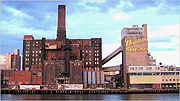
During the early 19th century some of the biggest industrial firms in the U.S began here, such as Pfizer Pharmaceuticals (1849), Astral Oil (later known as Standard Oil), Brooklyn Flint Glass (later Corning Ware), the Havemeyer and Elder sugar refinery (later Amstar and Domino). As well as D. Appleton & Company, U.S. publisher of Alice in Wonderland and Charles Darwin's The Origin of Species. Breweries like Schaefer, Rheingold and Schlitz along with docks, shipyards, refineries, mills and foundries opened along the waterfront. In 1851, the Williamsburgh Savings Bank, the Williamsburgh Dispensary, the Division Avenue ferry and three new churches were established. At one point during this period Williamsburg contained 10% of the wealth in the United States. Wealthy New Yorkers, including Cornelius Vanderbilt and Jim Fiske built mansions along the shore here. In 1855, the City of Williamsburgh along with the town of Bushwick became a part of Brooklyn. It was at this time, the "h" from the end of Williamsburg was dropped.
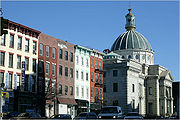
Part of New York City
Brooklyn became a part of New York city in 1898, which allowed Williamsburg to establish closer connections with the other boroughs. Construction on the Williamsburg bridge, the second to cross this river, began in 1896, and the bridge opened on December 19, 1903 at a cost of $12,000,000. At the time it was constructed, the Williamsburg Bridge set the record for the longest suspension bridge span on Earth. After it opened, an influx of people- mostly second generation Americans and wealthy immigrants from the lower east side came to settle in Williamburg. As an after effect, Williamsburg became the most densely populated area in New York city, which in itself was the most densely populated city in America.
Hasidic Population
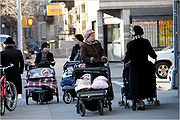
Williamsburg has a population of thousands of Hasidic Jews, most of whom are Satmar Hasidic. It is one of the fastest-growing communities in the world, as its families have a large amount of children. “According to the principal of the Satmar United Talmudical Academy and Beis Rochel Schools, the Satmar Rav Joel Teitelbaum, founded his day school in 1947 with seven boys, and girls' day school in 1947 with a dozen girls. Bolstered by the children of Holocaust survivors who settled in New York over the next decade, the Satmar Williamsburg school had 700 girls and 700 boys in their schools twelve years later in 1959.” The school is almost completely Satmar hassidic. The other hassidic groups in Williamsburg formed their own school networks. “In 1974, there were 3,500 students (until age 18) in New York's Satmar institutions - an increase of two and a half times in fifteen years. In 1998, some 25,000 students were spread throughout various Satmar schools in the greater New York area”. At present day, there are over 60,000 Satmar hasidic people living in Williamsburg, and the population continues to grow.
According to sources "The Satmar community of Williamsburg has eight to ten male births and the same number of female births, each week. Each year the community celebrates between 300 and 400 weddings. Satmar hasidim study almost exclusively in Yiddish in their schools. Of the nearly 200,000 Satmar adherents worldwide, over 70,000 live in Williamsburg, over 30,000 live in Kiryas Joel, 20,000 in Borough Park, and another few thousand in Monsey."
Articles discussing the construction of the Williamsburg Bridge
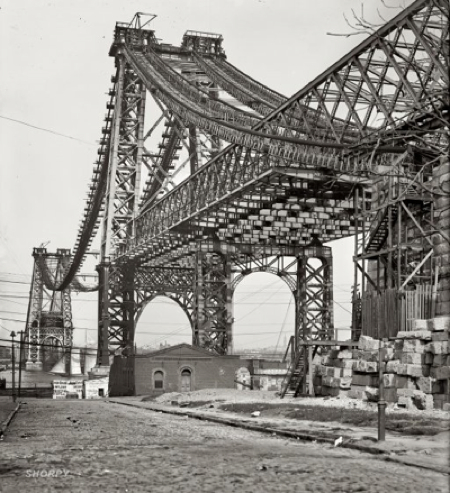
Brooklyn Eagle of February 15, 1902
The Brooklyn Eagle of February 15, 1902, in their article entitled, “Highway Out of Manhattan,”
discussed the construction of this bridge will “properly handle the people that will want to avail
themselves of the five elevated railroads in Brooklyn.” It also read, “by this system, one half of the
trains can go over the new bridge.” Again, it said that “this movement of trains will divert the greatest
number of people from the Brooklyn Bridge,” thus easing up traffic constrains.
New York Times of December 19th, 1903
The New York Times of December 19th, 1903 presented statistics comparing and contrasting the Brooklyn
and Williamsburg Bridges. Ultimately, the article was constructed in such a manner that would make any
dissenter of the Williamsburg Bridge recant and concur the Williamsburg Bridge was an asset to both New
York City and Brooklyn. The only areas in which the Brooklyn Bridge surpassed that of the Williamsburg was
in length of land spans, height above water at center.
New York Times of August 4th, 1915
The New York Times of August 4th, 1915 covered the construction of the Williamsburg bridge from the perspective of bridge Commissioner Kracke, and President Rowe. The title of the article is lengthy, and reads: “City Gets Offer to Run Bridge Cars: Three-Cent Line Would Like to Operate on the Williamsburg Span: Asks Ten-Year Contract: At End of That Period the City Would Own Cars, Tracks, Depot, and Elevators, Proposal Says.” Pretty self explanatory, right? To further the argument for the construction of the bridge, the article stated that the city would "install elevator service at the Brooklyn end of the bridge…so that the vast army of factory employees, male and female, employed near the water front who are compelled to utilize this bridge in going to and coming from their work may be saved the long walk which they now have to take."
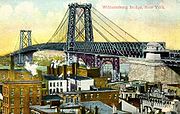
New York Times of October 14th, 1907
The last article read was found in the New York Times of October 14th, 1907, whereupon I came across the
first article I believed portrayed a negative consequence to the construction of the Bridge. Entitled, “Threat
to Abandon Seven Ferry Lines: The Brooklyn Ferry Company of New York, Which Operates 7 Ferry Lines
between Manhattan and Williamsburg, Unexpectedly Announced Last Night that Service Would be Discontinued.”
Again, another self-explanatory title, airing grievances over the cutting of jobs and services, questioning the
use of these Ferries after service would be suspended.
References
Check Out these Articles discussing the Bridge:
http://query.nytimes.com/gst/abstract.html?res=9E03E1D81E3EE033A2575BC2A9619C946496D6CF
http://query.nytimes.com/gst/abstract.html?res=9504EEDD1539E433A2575AC1A9649D946297D6CF&scp=4&sq=1903%20williamsburg%20bridge&st=cse
http://query.nytimes.com/gst/abstract.html?res=9904EEDE113CE733A25755C2A9659C946796D6CF
http://query.nytimes.com/gst/abstract.html?res=9D01E3D9153EE733A25754C0A9629C946897D6CF
http://query.nytimes.com/gst/abstract.html?res=9401E7DD1739E333A25754C1A96F9C946997D6CF
Sources for the History of Williamsburg:
http://chareidi.shemayisrael.com/archives5759/ach_ked/AKdemog.htm
http://www.brooklynpubliclibrary.org/ourbrooklyn/williamsburg/
http://en.wikipedia.org/wiki/Williamsburg